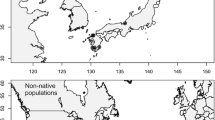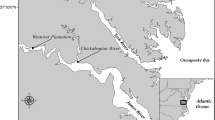Abstract
Eurasian watermilfoil (Myriophyllum spicatum) is often considered one of the most aggressive macrophyte invaders in freshwater habitats throughout the USA. However, conditions leading to successful milfoil invasions are not well understood. This study sought to illuminate the role of herbivores in determining milfoil invasion success via the potential mechanisms of enemy release and biotic resistance. We determined feeding preferences of three herbivores native to the northeastern United States and measured macrophyte phenolic content, which may act as an herbivore feeding deterrent. We found that phenolic content in milfoil was more than two times higher than in the most abundant native macrophytes at our study sites, consistent with enemy release. However, laboratory feeding experiments demonstrated that milfoil phenolics did not deter amphipod (Hyalella azteca), snail (Physella sp.), or weevil (Euhrychiopsis lecontei) herbivory. Furthermore, amphipod consumption rates in our study were an order of magnitude higher than amphipod consumption rates reported in milfoil’s native range, contrary to the predictions of enemy release. Amphipods and snails from habitats invaded by milfoil consumed similar quantities of both milfoil and the low-phenolic native plant Elodea canadensis. In contrast, weevils consumed milfoil but not E. canadensis in choice experiments. Amphipods collected from milfoil-free habitats also readily consumed milfoil, and they consumed 2.5 times more milfoil than E. canadensis in a choice feeding trial. These results suggest that high phenolic levels do not prevent native herbivores from consuming invasive milfoil. Instead, native generalist grazers like amphipods and snails may limit milfoil proliferation and provide a measure of biotic resistance.





Similar content being viewed by others
References
Agrawal AA, Kotanen PM, Mitchell CE, Power AG, Godsoe W, Klironomos J (2005) Enemy release? An experiment with congeneric plant pairs and diverse above- and belowground enemies. Ecology 86:2979–2989
Ali MM, Soltan MA (2006) Expansion of Myriophyllum spicatum (Eurasian water milfoil) into Lake Nasser, Egypt: invasive capacity and habitat stability. Aquat Bot 84:239–244
Bolser RC, Hay ME, Lindquist N, Fenical W, Wilson D (1998) Chemical defenses of freshwater macrophytes against crayfish herbivory. J Chem Ecol 24:1639–1658
Boylen CW, Eichler LW, Madsen JD (1999) Loss of native aquatic plant species in a community dominated by Eurasian watermilfoil. Hydrobiologia 415:207–211
Burks RL, Hensley SA, Kyle CH (2011) Quite the appetite: juvenile island apple snails (Pomacea insularum) survive consuming only exotic invasive plants. J Molluscan Stud 77:423–428
Caraco NF, Cole JJ (2002) Contrasting impacts of a native and alien macrophyte on dissolved oxygen in a large river. Ecol Appl 12:1496–1509
Chadwell TB, Engelhardt KAM (2008) Effects of pre-existing submersed vegetation and propagule pressure on the invasion success of Hydrilla verticillata. J Appl Ecol 45:515–523
Chase JM, Knight TM (2006) Effects of eutrophication and snails on Eurasian watermilfoil (Myriophyllum spicatum) invasion. Biol Invasions 8:1643–1649
Colautti RI, Ricciardi A, Grigorovich IA, MacIsaac HJ (2004) Is invasion success explained by the enemy release hypothesis? Ecol Lett 7:721–733
Creed RP, Sheldon SP (1994) The effect of two herbivorous insect larvae on Eurasian Watermilfoil. J Aquat Plant Manag 32:21–26
Creed RP, Sheldon SP (1995) Weevils and watermilfoil: did a North American herbivore cause the decline of an exotic plant? Ecol Appl 5:1113–1121
Crooks JA (2002) Characterizing ecosystem-level consequences of biological invasions: the role of ecosystem engineers. Oikos 97:153–166
Fleming JP, Dibble ED (2015) Ecological mechanisms of invasion success in aquatic macrophytes. Hydrobiologia 746:23–37
Fornoff F, Gross EM (2014) Induced defense mechanisms in an aquatic angiosperm to insect herbivory. Oecologia 175:173–185
Furstenberg-Hagg J, Zagrobelny M, Bak S (2013) Plant defense against insect herbivores. Int J Mol Sci 14:10242–10297
Gallardo B, Clavero M, Sanchez MI, Vila M (2016) Global ecological impacts of invasive species in aquatic ecosystems. Glob Chang Biol 22:151–163
Gordon D (1998) Effects of invasive, non-indigenous plant species on ecosystem processes: lessons from Florida. Ecol Appl 8:975–989
Gross E, Meyer H, Schilling G (1996) Release and ecological impact of algicidal hydrolysable polyphenols in Myriophyllum spicatum. Phytochemistry 41:133–138
Grutters BMC, Pollux BJA, Verberk WCEP, Bakker ES (2015) Native and non-native plants provide similar refuge to invertebrate prey, but less than artificial plants. PLoS ONE 10:e0124455
Heger T, Jeschke JM (2014) The enemy release hypothesis as a hierarchy of hypotheses. Oikos 123:741–750
Hierro JL, Maron JL, Callaway RM (2005) A biogeographical approach to plant invasions: the importance of studying exotics in their introduced and native range. J Ecol 93:5–15
Jeschke JM, Aparicio LG, Haider S, Heger T, Lortie CJ, Pysek P, Strayer DL (2012) Support for major hypotheses in invasion biology is uneven and declining. NeoBiota 14:1–20
Jester LL, Bozek MA, Helsel DR, Sheldon SP (2000) Euhrychiopsis lecontei distribution, abundance, and experimental augmentations for Eurasian watermilfoil control in Wisconsin lakes. J Aquat Plant Manag 38:88–97
Joshi J, Vrieling K (2005) The enemy release and EICA hypothesis revisited: incorporating the fundamental difference between specialist and generalist herbivores. Ecol Lett 8:704–714
Keane RM, Crawley MJ (2002) Exotic plant invasions and the enemy release hypothesis. Trends Ecol Evol 17:164–170
Kovalenko KE, Dibble ED (2011) Effects of invasive macrophyte on trophic diversity and position of secondary consumers. Hydrobiologia 663:167–173
Lemoine DG, Barrat-Segretain M-H, Roy A (2009) Morphological and chemical changes induced by herbivory in three common aquatic macrophytes. Internat Rev Hydrobiol 94:282–289
Les D, Mehrhoff L (1999) Introduction of nonindigenous aquatic vascular plants in southern New England: a historical perspective. Biol Invasions 1:281–300
Madsen JD (1998) Predicting invasion success of Eurasian watermilfoil. J Aquat Plant Manag 36:28–32
Madsen J (2005) Eurasian watermilfoil invasions and management across the United States. J Mar Educ 21:21–26
Marko MD, Newman RM, Gleason FK (2005) Chemically mediated host-plant selection by the milfoil weevil: a freshwater insect-plant interaction. J Chem Ecol 31:2857–2876
Marko MD, Gross EM, Newman RM, Gleason FK (2008) Chemical profile of the North American native Myriophyllum sibiricum compared to the invasive M. spicatum. Aquat Bot 88:57–65
Martin GD, Coetzee JA (2014) Competition between two aquatic macrophytes, Lagarosiphon major (Ridley) Moss (Hydrocharitaceae) and Myriophyllum spicatum Linnaeus (Halgoraceae) as influenced by substrate sediment and nutrients. Aquat Bot 114:1–11
Martin CW, Valentine JF (2011) Impacts of a habitat-forming exotic species on estuarine structure and function: an experimental assessment of Eurasian milfoil. Estuar Coasts 34:364–372
Martin CW, Valentine JF (2012) Eurasian watermilfoil invasion in estuaries: physical disturbance can reduce the proliferation of an aquatic nuisance species. Mar Ecol Prog Ser 449:109–119
Morrison WE, Hay ME (2011) Herbivore preference for native vs. exotic plants: generalist herbivores from multiple continents prefer exotic plants that are evolutionarily naïve. PLoS ONE 6(3):e17227
Newman RM (2004) Invited review—biological control of Eurasian watermilfoil by aquatic insects: basic insights from an applied problem. Arch Hydrobiol 159:145–184
Newman RM, Biesboer DD (2000) A decline of Eurasian watermilfoil in Minnesota associated with the milfoil weevil, Euhrychiopsis lecontei. J Aquat Plant Manag 38:105–111
Newman RM, Ragsdale DW, Milles A, Oien C (2001) Overwinter habitat and the relationship of overwinter to in-lake densities of the milfoil weevil, Euhrychiopsis lecontei, a Eurasian watermilfoil biological control agent. J Aquat Plant Manag 39:63–67
Orav-Kotta H, Kotta J, Herkul K, Kotta I, Paalme T (2009) Seasonal variability in the grazing potential of the invasive amphipod Gammarus tigrinus and the native amphipod Gammarus salinus (Amphipoda: Crustacea) in the northern Baltic Sea. Biol Invasions 11:597–608
Parker JD, Hay ME (2005) Biotic resistance to plant invasions? Native herbivores prefer non-native plants. Ecol Lett 8:959–967
Parker JD, Burkepile DE, Hay ME (2006) Opposing effects of native and exotic herbivores on plant invasions. Science 311:1459–1461
Pimentel D, Zuniga R, Morrison D (2005) Update on the environmental and economic costs associated with alien-invasive species in the United States. Ecol Econ 52:273–288
Prior KM, Powell THQ, Joseph AL, Hellman JJ (2015) Insights from community ecology into the role of enemy release in causing invasion success: the importance on native enemy effects. Biol Invasions 17:1283–1297
Quinn GP, Keough MJ (2002) Experimental design and data analysis for biologists. Cambridge University Press, New York
Rodriguez LF (2006) Can invasive species facilitate native species? Evidence of how, when, and why these impacts occur. Biol Invasions 8:927–939
Schultz R, Dibble E (2012) Effects of invasive macrophytes on freshwater fish and macroinvertebrate communities: the role of invasive plant traits. Hydrobiologia 684:1–14
Sheldon SP, Creed RP (1995) Use of a native insect as a biological control for an introduced weed. Ecol Appl 5:1122–1132
Smith C, Barko J (1990) Ecology of Eurasian watermilfoil. J Aquat Plant Manag 28:55–64
Steele L, Valentine J (2015) Seagrass deterrence to mesograzer herbivory: evidence from mesocosm experiments and feeding preference trials. Mar Ecol Prog Ser 524:83–94
Sutter TJ, Newman RM (1997) Is predation by sunfish (Lepomis spp.) an important source of mortality for the Eurasian watermilfoil biocontrol agent Euhrychiopsis lecontei? J Freshw Ecol 12:225–234
Swain T, Goldstein JL (1964) The quantitative analysis of phenolic compounds. In: Pridham JB (ed) Methods in polyphenol chemistry. MacMillan, New York, pp 131–146
Valinoti CE, Chuan-Kai J, Armitage AR (2011) Native and exotic submerged aquatic vegetation provide different nutritional and refuge values for macroinvertebrates. J Exp Mar Biol Ecol 409:42–47
Ward DM, Newman RM (2006) Fish predation on Eurasian watermilfoil (Myriophyllum spicatum) herbivores and indirect effects on macrophytes. Can J Fish Aquat Sci 63:1049–1057
Wilcove DS, Rothstein D, Dubow J, Phillips A, Losos E (1998) Quantifying threats to imperiled species in the United States. Bioscience 48:607–615
Wilson SJ, Ricciardi A (2009) Epiphytic macroinvertebrate communities on Eurasian watermilfoil (Myriophyllum spicatum) and native milfoils Myriophyllum sibericum and Myriophyllum alterniflorum in eastern North America. Can J Fish Aquat Sci 66:18–30
Xiong W, Yu D, Wang Q, Liu C, Wang L (2008) A snail prefers native over exotic freshwater plants: implications for the enemy release hypotheses. Freshw Biol 53:2256–2263
Zhu B, Georgian SE (2014) Interactions between invasive Eurasian watermilfoil and native water stargrass in Cayuga Lake, NY, USA. J Plant Ecol 7:499–508
Acknowledgements
Jessica Michaud, Julie Bettke, Connor Trymbulak, Dan Perez, and Dale Mack assisted with specimen collection and sorting and with laboratory experiments. Dale Mack assisted with phenolic content analysis. This work was funded by a Sacred Heart University Research and Creativity Grant to LaTina Steele and a United States Geological Survey 104B Grant via the Connecticut Institute of Water Resources awarded to LaTina Steele and Michele Guidone (Primary Award #G11AP20069, Subaward #59773).
Author information
Authors and Affiliations
Corresponding author
Ethics declarations
Conflict of interest
All authors declare that they have no conflict of interest.
Ethical standard
All applicable institutional and/or national guidelines for the care and use of animals were followed.
Additional information
Handling Editor: Kevin Murphy.
Rights and permissions
About this article
Cite this article
Steele, L., Ray, C. & Guidone, M. High phenolic content fails to deter mesograzer consumption of Myriophyllum spicatum (Eurasian watermilfoil) in New England. Aquat Ecol 52, 255–267 (2018). https://doi.org/10.1007/s10452-018-9661-8
Received:
Accepted:
Published:
Issue Date:
DOI: https://doi.org/10.1007/s10452-018-9661-8




